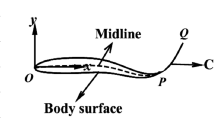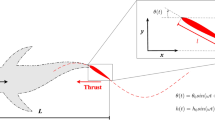Abstract
Passive flexibility was found to enhance propulsive efficiency in swimming animals. In this study, we numerically investigate the roles of structural resonance and hydrodynamic wake resonance in optimizing efficiency of a flexible plunging foil. The results indicates that (1) optimal efficiency is not necessarily achieved when the driving frequency matches the structural eigenfrequency; (2) optimal efficiency always occurs when the driving frequency matches the wake resonant frequency of the time averaged velocity profile. Thus, the underlying principle of efficient propulsion in flexible plunging foil is the hydrodynamic wake resonance, rather than the structural resonance. In addition, we also found that whether the efficiency can be optimized at the structural resonant point depends on the strength of the leading edge vortex relative to that of the trailing edge vortex. The result of this work provides new insights into the role of passive flexibility in flapping-based propulsion.
Similar content being viewed by others
References
Liu, G., Ren, Y., Zhu, J.Z., et al.: Thrust producing mechanisms in ray-inspired underwater vehicle propulsion. Theor. Appl. Mech. Lett. Doi: 10.1016/j.taml.2014.12.004 (2015)
Tang, C., Lu, X.Y.: Propulsive performance of two- and three-dimensional flapping flexible plates. Theor. Appl. Mech. Lett. Doi: 10.1016/j.taml.2015.01.010 (2015)
Wang, S.Z., Zhang, X., He, G.W., et al.: Numerical simulation of unsteady flows over a slow-flying bat. Theor. Appl. Mech. Lett. Doi: 10.1016/j.taml.2015.01.006 (2015)
Yu, Y.L., Guan, Z.W.: Learning from bat: aerodynamics of actively morphing wing. Theor. Appl. Mech. Lett. Doi: 10.1016/j.taml.2015.01.009 (2015)
Shyy, W., Anon, H., Chimakurthi, S.K., et al.: Recent progress in flapping wing aerodynamics and aeroelasticity. Prog. Aerosp. Sci. 46, 284–327 (2010)
Michelin, S.B., Llewellyn Smith, S.G.: Resonance and propulsion performance of a heaving flexible wing. Phys. Fluids 21, 071902 (2009)
Ramananarivo, S., Godoy-Diana, R., Thiria, B.: Rather than resonance, flapping wing flyers may play on aerodynamics to improve performance. Proc. Natl. Acad. Sci. U.S.A. 108, 5964–5969 (2011).
Triantafyllou, G.S., Triantafyllou, M.S., Grosenbaugh, M.A.: Optimal thrust development in oscillating foils with application to fish propulsion. J. Fluids Struct. 7, 205–224 (1993)
Moored, K.W., Dewey, P.A., Smits A.J., et al.: Hydrodynamic wake resonance as an underlying principle of efficient unsteady propulsion. J. Fluid Mech. 708, 329–348 (2012)
Moored, K.W., Dewey, P.A., Boschitsch, B.M., et al.: Linear instability mechanisms leading to optimally efficient locomotion with flexible propulsors. Phys. Fluids 26, 041905 (2014)
Huang, W.X., Shin, S.J., Sung, H.J.: Simulation of flexible filaments in a uniform flow by the immersed boundary method. J. Comput. Phys. 226, 2206–2228 (2007)
Zhu, X.J., He, G.W., Zhang, X.: Numerical study on hydrodynamic effect of flexibility in a self-propelled plunging foil. Compt. Fluids 97, 1–20 (2014)
Zhu, X.J., He, G.W., Zhang, X.: How flexibility affects the wake symmetry properties of a self-propelled plunging foil. J. Fluid Mech. 571, 164–183 (2014)
Wang, S., Zhang, X.: An immersed boundary method based on discrete stream function formulation for two- and three-dimensional incompressible flows. J. Comput. Phys. 230, 3479–3499 (2011)
Zhu, X.J., He, G.W., Zhang, X.: An improved direct-forcing immersed boundary method for fluid-structure interaction simulations. J. Fluids Eng. 136, 040903 (2014)
Mattingly, G.E., Criminale, W.O.: The stability of an incompressible two-dimensional wake. J. Fluid Mech. 51, 233–272 (1972)
Orszag, S.A.: Accurate solution of the Orr-Sommerfeld stability equation. J. Fluid Mech. 50, 689–703 (1971)
Bridges, T.J., Morris, P.J.: Differential eigenvalue problems in which the parameter appears nonlinearly. J. Comput. Phys. 55, 437–460 (1984)
Author information
Authors and Affiliations
Corresponding author
Additional information
The project was supported by the National Natural Science Foundation of China (11232011, 11021262, and 11023001) and the National Basic Research Program of China (2013CB834100).
Rights and permissions
About this article
Cite this article
Zhu, XJ., He, GW. & Zhang, X. Underlying principle of efficient propulsion in flexible plunging foils. Acta Mech Sin 30, 839–845 (2014). https://doi.org/10.1007/s10409-014-0114-x
Received:
Revised:
Accepted:
Published:
Issue Date:
DOI: https://doi.org/10.1007/s10409-014-0114-x




